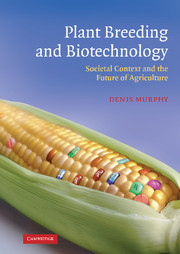Book contents
- Frontmatter
- Contents
- Preface
- Acknowledgements
- Using this book
- Nomenclature and terminology
- Abbreviations and glossary
- Introduction
- Part I The science of plant breeding
- Part II The societal context of plant breeding
- Part III Turmoil and transition: the legacy of the 1980s
- 7 Resurgence of the private sector
- 8 Emergence of a new crop improvement paradigm
- 9 Decline of the public sector
- 10 Reaping the consequences
- Part IV The agbiotech paradigm
- Part V Increasing global crop production: the new challenges
- Part VI Plant breeding in the twenty-first century
- Notes
- References
- Index
8 - Emergence of a new crop improvement paradigm
Published online by Cambridge University Press: 07 May 2010
- Frontmatter
- Contents
- Preface
- Acknowledgements
- Using this book
- Nomenclature and terminology
- Abbreviations and glossary
- Introduction
- Part I The science of plant breeding
- Part II The societal context of plant breeding
- Part III Turmoil and transition: the legacy of the 1980s
- 7 Resurgence of the private sector
- 8 Emergence of a new crop improvement paradigm
- 9 Decline of the public sector
- 10 Reaping the consequences
- Part IV The agbiotech paradigm
- Part V Increasing global crop production: the new challenges
- Part VI Plant breeding in the twenty-first century
- Notes
- References
- Index
Summary
Crop improvements like these can help provide an abundant, healthful food supply and protect our environment for future generations.
Monsanto website, 2005Introduction
We have seen that the major driving force behind the massive private sector expansion into crop development of the 1980s and 1990s was the development of transgenic crops. Unlike other types of crop, transgenic varieties could be protected via the utility patent route, which gave a much more powerful form of ownership than plant breeders' rights. Companies who wished to develop transgenic crops were further assisted by a relatively lax patenting regime, especially before 1995. During this period, many patents were granted that, even at the time, were recognised as being of inordinate breadth in the scope of their claims. Therefore, the emergence of the private sector as the dominant player in crop breeding was stimulated by the conjunction of new legislation and new technologies, the combination of which allowed companies to develop potentially lucrative business models in a hitherto rather unprofitable area of agricultural commerce. The much trumpeted entry of the private sector en masse into the marketplace for crop improvement came at a time when many governments in industrialised countries were seeking to shed much of their public sector enterprises via the mechanism of privatisation. We will examine this topic in more detail, especially in regard to UK plant breeding research, in the next chapter.
- Type
- Chapter
- Information
- Plant Breeding and BiotechnologySocietal Context and the Future of Agriculture, pp. 115 - 125Publisher: Cambridge University PressPrint publication year: 2007



